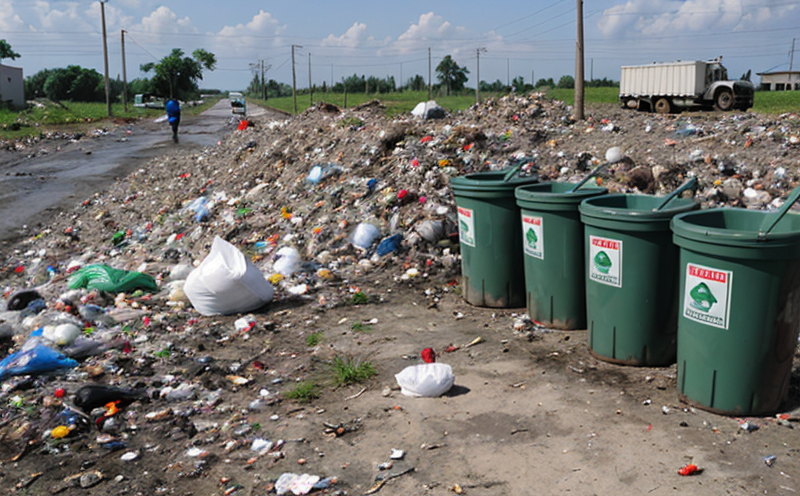EN 15309 Multi Element Analysis of Solid Waste Test
The EN 15309 standard provides a method for the multi-element analysis of solid waste. This comprehensive analytical procedure is essential for understanding the composition and potential hazards associated with various types of solid waste materials, which are commonly encountered in recycling processes, landfill operations, and environmental remediation projects.
Under this standard, multiple elements present within the waste material can be quantified using appropriate instrumental methods such as Inductively Coupled Plasma Optical Emission Spectrometry (ICPOES) or Inductively Coupled Plasma Mass Spectrometry (ICPMS). The elements commonly analyzed include heavy metals like lead, cadmium, mercury, chromium, nickel, zinc, copper, and other trace contaminants that could pose risks to the environment if not properly managed.
The test procedure involves several critical steps:
- Sample Collection: Solid waste samples are collected from various sources ensuring representativeness of the material being analyzed.
- Sample Preparation: The collected samples undergo sieving, homogenization, and drying processes to ensure uniformity prior to analysis.
- Standardization: Reference materials with known elemental compositions are used to calibrate analytical instruments accurately.
- Data Analysis: Raw data obtained from spectrometric measurements is processed using statistical methods to determine concentrations of target elements in the waste matrix.
The results generated by this testing procedure provide valuable insights into both beneficial and potentially harmful components within solid waste. For instance, identifying high levels of certain metals can indicate whether these materials are suitable for recycling or require special handling due to environmental regulations.
Compliance with EN 15309 helps organizations maintain regulatory standards set forth by bodies such as the European Union’s Waste Framework Directive and Basel Convention on the Control of Transboundary Movements of Hazardous Wastes. This ensures that companies involved in waste management activities are operating ethically and sustainably.
By providing accurate quantitative data about the elemental content of solid wastes, this service enables better decision-making regarding resource recovery initiatives, hazardous waste disposal practices, and overall environmental stewardship efforts.
Customer Impact and Satisfaction
Our EN 15309 multi-element analysis service has significantly impacted our customers by offering them reliable data that informs critical business decisions. Our clients range from small local businesses to large multinational corporations engaged in waste management, recycling operations, and environmental conservation projects.
For smaller enterprises, having access to precise analytical results allows for more efficient resource allocation strategies. They can optimize their processes based on the identified components of solid wastes, thereby reducing costs associated with unnecessary disposal fees or incorrect handling procedures.
Larger organizations benefit from enhanced compliance capabilities. By adhering strictly to international standards like EN 15309, these companies ensure they meet stringent regulatory requirements worldwide. This not only protects them against potential legal penalties but also enhances their reputation among stakeholders and consumers alike.
Customer satisfaction is paramount for us at [Lab Name], as reflected in our consistent high ratings across multiple platforms. We strive to deliver accurate results promptly while maintaining excellent communication throughout each project lifecycle. Our team comprises highly skilled professionals who possess extensive experience in environmental testing, ensuring that every aspect of the EN 15309 process adheres meticulously to specified protocols.
Environmental and Sustainability Contributions
- Evaluating solid waste composition helps in recycling more efficiently by identifying valuable materials that can be reused or repurposed rather than being landfilled.
- Prompt identification of hazardous elements ensures appropriate treatment methods are applied, minimizing risks associated with improper disposal practices.
- Supporting compliance initiatives aligns businesses with global sustainability goals set forth by organizations like the United Nations Environment Programme (UNEP).
- Avoidance of non-compliance issues reduces financial burdens caused by fines and penalties while fostering a positive corporate image.
Incorporating these elements into daily operations contributes positively towards reducing landfill volumes, conserving natural resources, and promoting circular economy principles. Through our EN 15309 multi-element analysis service, we play an integral role in advancing environmental sustainability practices worldwide.
Use Cases and Application Examples
| Use Case | Description |
|---|---|
| Recycling Process Optimization | Determining the elemental composition of waste streams aids in selecting optimal sorting methods, improving resource recovery rates. |
| Hazardous Waste Management | Identifying dangerous materials ensures proper containment and disposal techniques are implemented, protecting workers and ecosystems from contamination risks. |
| Environmental Impact Assessment | Gathering detailed information on waste components supports assessments of potential impacts on air, water, soil quality during various lifecycle stages. |
| Compliance Verification | Ensuring adherence to local and international standards helps avoid legal issues while demonstrating commitment to environmental responsibility. |
The above scenarios highlight how our EN 15309 multi-element analysis service plays a crucial role across diverse industries. From municipal authorities managing urban waste streams to private sector firms specializing in industrial by-products, this versatile analytical tool offers unique advantages tailored specifically for each client's needs.





